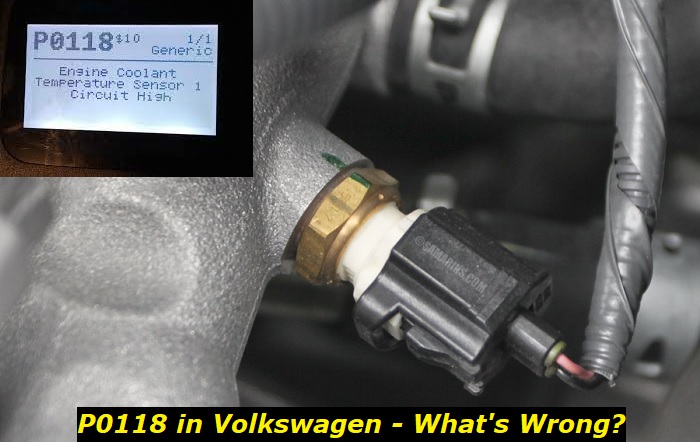Volkswagen is one of the strong foundations of the auto industry. It is known for the quality of its vehicles and its knack for innovation. All these make its products very reliable, which is among its key selling points.
P0118 code highlights
- Level of urgency:High
- Possible culprits:engine coolant temp sensor dead, wiring problems
- Price for repair:$50 - $250
- If neglected:You won't know if the engine overheats
- DIY repairs:Possible
- Can you drive?Carefully

What the Fault Code Means for Volkswagen Vehicles
The P0118 fault code comes with the description "Engine Coolant Temperature (ECT) Sensor Circuit High Open Problem". As indicated here, the issue likely lies in the sensor's circuitry. However, there is also a possibility that there are other factors at play in this kind of problem.
If the P0118 fault code on a Volkswagen vehicle is ignored for too long, it can have disastrous effects. The most serious effect of this warning is an overheating engine. If left unchecked, the entire cooling system will likely fail and require expensive repairs or replacement parts.
Additionally, if the engine runs too hot for too long, other components such as spark plugs and fuel injectors may become damaged or contaminated. This could lead to further problems with engine performance, potentially resulting in costly breakdowns and reduced efficiency from the vehicle overall.
Likewise, ignoring a P0118 warning could also put a strain on the vehicle's battery, leading to a shortened life expectancy and even complete electrical failure down the line. To prevent any long-term damage or performance issues, it is important to address the issue as soon as the P0118 warning is illuminated.
Because of all these potential drawbacks, it is essential for Volkswagen owners to be mindful and attentive when a P0118 fault code appears on their vehicle's dashboard. Failure to do so can result in long-term damage or costly repairs that could have been avoided if the problem had been addressed promptly.
It is always best to take care of any potential engine problems quickly before they become too serious and cause more damage down the line. The P0118 fault code should not be overlooked or left unchecked because even seemingly small issues can lead to big headaches if ignored for too long. Taking preventive measures now can save time and money in the future.
Most Common Culprits of the P0118 Fault Code in Volkswagen
To prevent the problem from getting worse, one must be able to recognize the primary signs of the problem at its early stages. Knowing where to start looking for the source of the problem greatly helps in the quick resolution of the issue, too.
When diagnosing the possible cause of the problem in order to determine the best possible solution for it, the following are the parts that can provide you with a good starting point in your inspection:
1. ECT Sensor Failure
When diagnosing the most likely cause of the fault code that you are experiencing in your Volkswagen unit, it's always good to start from the part that the warning is pointing at. In this case, it's the ECT sensor.
Begin with a visual inspection of the sensor. A clean and properly functioning ECT sensor should be securely attached to the engine block, free from any corrosion or damage that might be compromising its performance. If there are signs of damage or corrosion, then this could indicate that it's time for a replacement.
You also want to make sure that all of the wires leading to and from the sensor are in good condition, as any fraying or loose connections can also be responsible for triggering this fault code.
Inspecting the electrical system is another important step when diagnosing an ECT sensor issue. Using a multimeter can help you check if there is proper continuity between connectors and pins on both sides of the sensor. A faulty ECT sensor could also be indicated by a reading that's either too high or too low, depending on the type of vehicle you have.
In some cases, simply replacing the ECT sensor may resolve the issue, but it's important to check for any other underlying problems first before doing so. If your unit is equipped with an ECU-controlled fan, then it's recommended to check if there are any problems with its wiring and operation as well, as this can also affect the effectiveness of the ECT sensor.
Using a scan tool can often provide more detailed information about what's wrong with the system, allowing you to confirm whether or not a specific part is causing the problem. If you are able to access diagnostic trouble codes with a scan tool, then it may point to other components in the system that need to be checked for faults as well.
Ultimately, diagnosing an ECT sensor issue that is causing the P0118 fault code can often reveal deeper issues in your Volkswagen unit's electrical system. It's important to take time and perform all of these checks thoroughly to ensure that any necessary repairs or replacements can be done correctly and efficiently.
2. Contaminated Coolant
To check the level and quality of coolant in a Volkswagen car that is producing a P0118 fault code, one must raise the front end of the car by either putting it up on jack stands or ramps. Make sure that the parking brake is engaged and shifted into gear before getting under the vehicle. Once underneath, visually inspect all hoses, clamps, connectors, and other components for visible signs of leakage or corrosion.
Next, take off the radiator cap when the engine has cooled down to ensure that there is enough coolant inside. If necessary, add additional coolant to bring it up to the required levels but do not overfill as this can also cause issues with overheating.
Additionally, inspect the coolant itself for any impurities such as oil, dirt, or bits of metal. This can indicate an issue with the cooling system that must be addressed immediately before further damage is done to the engine.
When the problem causing this fault code is insufficient or contaminated coolant, typical symptoms include excessive white smoke coming from the exhaust pipe, a sweet odor in the cabin, and a decrease in fuel efficiency.
Moreover, drivers may experience their engine temperature gauge rising excessively high when driving even at normal speeds. It is important to take note of these indicators to prevent any further issues with the vehicle's cooling system.
The solution for this particular problem involves replacing any damaged hoses and clamps, refilling with fresh coolant, and testing if necessary to make sure that the system is operating correctly. If there are any signs of corrosion with other components such as the radiator, then they should be replaced or repaired as soon as possible to prevent further damage.
3. ECU Malfunction
To diagnose the P0118 fault code in Volkswagen cars, it is important to have access to a diagnostic scanner. The Diagnostic Trouble Code (DTC) associated with this fault code should be retrieved first before proceeding with further diagnosis.
Diagnosis should include verification of the sensor wiring and connections, as well as checking for any signs of corrosion or damage. It's also necessary to verify that the ECU has proper voltage supply and ground connection.
The symptoms produced by an ECU malfunction that activates the P0118 fault code may vary depending on the severity of the issue. Common symptoms include hard starting, poor fuel economy, reduced engine power output, and stalling at idle speeds. There may also be others such as triggering the check engine light and misfires in the cylinders.
The solution to the problem depends on what is causing it. For software issues, reflashing may be necessary to resolve the issue. If the ECU hardware has failed, then replacing it with a new or refurbished unit is recommended.
In some cases, a defective voltage regulator may also be responsible for an ECU malfunction that activates this code, so that should also be checked before any further diagnosis takes place.
Check the manufacturer's recommendations for additional information regarding repair procedures and steps that must be followed for proper diagnosis of this fault code. For electrical issues, checking all wiring connectors and replacing any worn-out components will help restore the full functionality of the system as well.
Lastly, see to it that you perform a visual inspection of the engine compartment and the ECU to ensure that nothing is obstructing its normal operation. By following these steps, the underlying cause of this fault code can be determined and corrected.
Conclusion
The P0118 fault code pointing to "Engine Coolant Temperature (ECT) Sensor Circuit High Open Problem" should be diagnosed and addressed immediately at its onset. The failure to do so can result in the issue gradually getting worse until it spreads over to other parts of the vehicle.
The worst that could happen is engine overheating due to the sensor's failure to do its part as well as electrical faults that could be a source of more serious damage.
About the authors
The CarAraC research team is composed of seasoned auto mechanics and automotive industry professionals, including individuals with advanced degrees and certifications in their field. Our team members boast prestigious credentials, reflecting their extensive knowledge and skills. These qualifications include: IMI: Institute of the Motor Industry, ASE-Certified Master Automobile Technicians; Coventry University, Graduate of MA in Automotive Journalism; Politecnico di Torino, Italy, MS Automotive Engineering; Ss. Cyril and Methodius University in Skopje, Mechanical University in Skopje; TOC Automotive College; DHA Suffa University, Department of Mechanical Engineering






Add comment